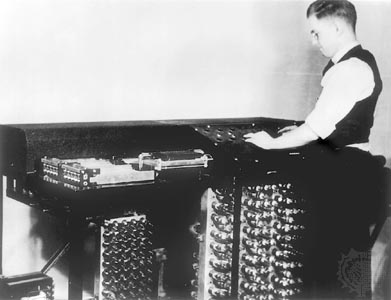Atanasoff-Berry Computer
 an early digital computer. It was generally believed that the first electronic digital computers were the Colossus, built in England in 1943, and the ENIAC, built in the United States in 1945. However, the first special-purpose electronic computer may actually have been invented by John Vincent Atanasoff, a physicist and mathematician at Iowa State College (now Iowa State University), during 1937–42. (Atanasoff also claimed to have invented the term analog computer to describe machines such as Vannevar Bush (Bush, Vannevar)'s differential analyzer.) Together with his graduate assistant Clifford E. Berry, Atanasoff built a successful small prototype in 1939 for the purpose of testing two ideas central to his design: capacitors to store data in binary (binary number system) form and electronic logic circuits to perform addition and subtraction. They then began the design and construction of a larger, more general-purpose computer, known as the Atanasoff-Berry Computer or the ABC.
an early digital computer. It was generally believed that the first electronic digital computers were the Colossus, built in England in 1943, and the ENIAC, built in the United States in 1945. However, the first special-purpose electronic computer may actually have been invented by John Vincent Atanasoff, a physicist and mathematician at Iowa State College (now Iowa State University), during 1937–42. (Atanasoff also claimed to have invented the term analog computer to describe machines such as Vannevar Bush (Bush, Vannevar)'s differential analyzer.) Together with his graduate assistant Clifford E. Berry, Atanasoff built a successful small prototype in 1939 for the purpose of testing two ideas central to his design: capacitors to store data in binary (binary number system) form and electronic logic circuits to perform addition and subtraction. They then began the design and construction of a larger, more general-purpose computer, known as the Atanasoff-Berry Computer or the ABC.Various components of the ABC were designed and built from 1939 to 1942, but development was discontinued with the onset of World War II. The ABC featured about 300 vacuum tubes (electron tube) for control and arithmetic calculations, use of binary numbers, logic operations (instead of direct counting), memory capacitors, and punched cards as input/output units (input/output device). (At Atanasoff's invitation, another early computer pioneer, John Mauchly (Mauchly, John W.), stayed at Atanasoff's home and was freely shown his work for several days in June 1941. For more on the ramifications of this visit, see BTW: Computer patent wars.)
- Spalding, Albert
- Spalding, Henry Harmon
- Spalding, Mother Catherine
- Spallanzani, Lazzaro
- spallation
- spam
- Spandau
- spandrel
- Spangenberg, August Gottlieb
- spaniel
- Spanish-American War
- Spanish Civil War
- Spanish Fork
- Spanish lace
- Spanish language
- Spanish lime
- Spanish literature
- Spanish Marriages, Affair of the
- Spanish moss
- Spanish Netherlands
- Spanish North Africa
- Spanish Riding School of Vienna
- Spanish Socialist Workers' Party
- Spanish Succession, War of the
- Spanish Town